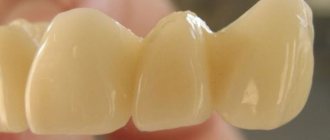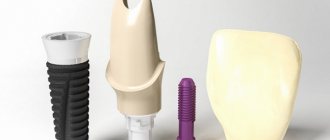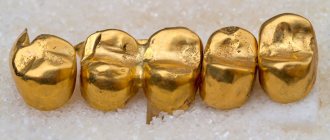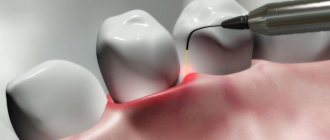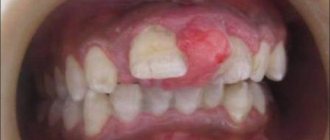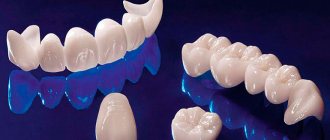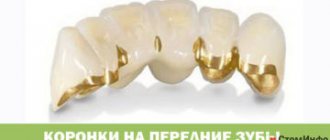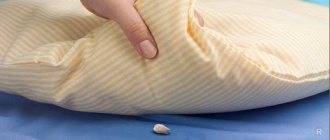One of the common reasons for repeated visits to an orthopedic dentist is a complaint that the crown is constantly in the way. Patients report various subjective sensations, from slight interference from time to time to intense pain and the inability to close the teeth. There are several reasons for this phenomenon; it can be either poor quality work of a doctor or technician, or a symptom of a disease. Accordingly, the approach to eliminating the problem may be different.
Features of metal-ceramic crowns
An artificial crown made of metal-ceramics has a durable metal base, which is covered on top with a layer of ceramic mass, identical in color to natural enamel. The cladding is carried out in layers - each subsequent layer is subjected to thermal treatment in a special oven at the highest temperature - from 800 degrees. This technology allows you to achieve maximum adhesion strength between the metal frame and the facing material. You can see what your smile looks like before and after treatment in the photo below.
Before installing the finished structure, the tooth will have to be sharpened - preparation is necessary to accurately match the shape of the internal cavity of the crown. The product is attached using a special composite material or dental cement. If the tooth is too damaged, the specialist will first strengthen the root with a special pin or fix a stump inlay, which will become the basis for fixing the product. The material is widely used, including in bridges, partial or complete tooth-replacement devices, supported on living teeth or on implants.
Manufacturing of metal-ceramic prosthesis
The procedure for making a metal-ceramic prosthesis consists of several stages, including mandatory intermediate monitoring of compliance with the patient’s needs. First, the doctor makes a detailed impression of the patient’s dentition from a special hardening mass, on the basis of which a plaster cast of the jaw is cast. The metal frame of the structure is modeled in wax and then sent to a foundry, where the base is cast from the specified metal joints.
The finished metal base is tried on, adjusted if necessary, and returned to the dental technicians for applying the ceramic coating. The ceramic coating is applied to the metal frame in layers; the shape of the future tooth is determined by the technologist in accordance with the individual impression of the patient’s jaw. The work is done manually, which allows you to accurately replicate the natural shape of the tooth.
To give the product strength and strengthen the chemical bond between the components of the materials, after applying ceramics, the prosthesis is fired in a special oven at a temperature of 800–900 °C. The structure is covered on top with a thin layer of special enamel that matches the natural shade.
Then the final fitting is carried out: the correspondence of the crown to the color of the natural enamel and the anatomical features of the patient’s jaw is checked. Only after this the crown is covered with a shiny glaze and undergoes final firing.
How are they different from other models?
Metal-ceramic crowns differ from all-ceramic single dentures by the presence of a metal frame. This feature makes them not entirely suitable for restoring the smile area - over time, the base will begin to appear, which will negatively affect the aesthetics as a whole. At the same time, products made entirely of ceramics are not suitable for restoration of the chewing area - the material is quite fragile and is susceptible to cracks and chips under intense chewing loads. Therefore, the answer to the question of how these two types of prostheses differ and what is better to install cannot be unambiguous - when choosing one or another option, one must be guided primarily by the location of the defects.
If we compare metal-ceramics with solid metal structures, then the latter are much inferior in aesthetics - they have a silvery color and can be noticeable when smiling, and are suitable exclusively for replacing molars. And in principle, this option has long been a thing of the past - gold crowns were popular in the 90s and were not so much a good option for restoring teeth, but an indicator of the status of their owner.
Crown made of zirconium dioxide - 12,500 rub.
The price includes all manipulations for the manufacture, installation and fitting of the crown, as well as taking impressions.
Creation of a Prettau zirconium dioxide crown in 1 day, using 3D CAD/CAM modeling technology. Save RUR 5,500 >> Call now or request a call
Working hours: from 9:00 to 21:00 - seven days a week
There is another option for creating products - from zirconium dioxide material, and today this is one of the best solutions that combines reliability and natural appearance. Compared to metal-ceramics, this material is more durable and at the same time aesthetically pleasing for the restoration of anterior incisors. We will talk in more detail about alternative materials for creating crowns a little later, but for now let’s move on to the indications and restrictions for installation.
How does having crowns affect your ability to chew?
Throughout life, a person’s teeth are exposed to a whole range of destructive factors. The main ones are caries, its complications and occlusal (chewing) overload.
Tooth filling for caries is usually carried out with composite light-curing fillings. Over time, with repeated treatment, the volume of the tooth’s own tissues decreases, and the volume of the filling increases. This causes additional stress on the remaining tooth walls and increases the risk of chipping. In addition, the composite material from which the fillings are made is softer in properties than the teeth’s own enamel and is more susceptible to abrasion when chewing.
The filling wears off, becomes flatter and loses its shape over time. As a result, the density of closure with the opposite tooth – the antagonist – decreases. The chewing load is redistributed to neighboring teeth, which can cause a number of complications: chips, fractures of teeth, pathological abrasion, wedge-shaped defects.
The ability of a tooth to chew food effectively is determined by its anatomy (structure) and position in the dentition. The chewing surface of the molars consists of cusps and fissures (grooves between the cusps). When chewing, the cusps of the upper teeth fall into the fissures of the lower teeth and vice versa. This closure of the teeth ensures free chewing of food and proper distribution of the load.
When the filling wears off, the first thing that occurs is the reduction of the cusps of the chewing teeth, since they experience the greatest load when closing. The surface of the tooth becomes flat and does not allow you to chew food effectively.
What does the doctor take into account when restoring teeth in Megastom?
The most important thing is the degree of tooth destruction and the amount of remaining healthy tissue.
If the tooth is slightly damaged, it is preferable to restore it with a filling. The main load falls on the tooth’s own tissues and the abrasion of the filling will be low.
In case of significant damage, a crown must be made. It is preferable to make crowns on living teeth with preserved nerves, which is practiced in the Megastom clinics. Since pulpless teeth (without a nerve) become fragile and serve much less.
To make a crown, the tooth is minimally processed in a certain way. Then an impression of the jaw is taken or it is scanned. In most cases, Megastom clinics use a modern oral scanner, which makes it possible to avoid the traditional procedure of taking impressions.
While the permanent crown is being made, a temporary plastic crown is placed on the treated tooth. A dental technician in the Megastom laboratory makes a plaster model of the jaw or prints it on a 3D printer
On this model, an exact copy of the patient’s teeth, the crown is modeled. The finished crown is fixed to the tooth using special glass ionomer cement. The chewing surface of crowns is made of either ceramic or Prettau zirconia. These are very durable materials that are not subject to abrasion in the mouth.
Having accurate models of the jaws, the dental technician completely restores the structure of the tooth on the crown and forms the correct closure of the cusps and fissures, which is not always possible to do in the oral cavity with the help of a filling. The crown, like a cap, covers the tooth, distributes the chewing load and prevents chipping of thin walls.
Timely prosthetics and replacing the filling with a crown can save the tooth and prevent pulp loss, and restore the chewing function of the tooth.
If you want to carry out high-quality dental prosthetics in Moscow, then when choosing a clinic, take into account the qualifications and experience of doctors, technologies and materials used in the clinic.
Indications and contraindications for installation
Among the indications for the installation of metal-ceramic crowns, experts in the field of prosthetics identify the following conditions:
- restoration of chewing units,
- recreating one lost element,
- use in bridges, partial and complete dentures,
- during restoration on implants,
- to replace old or damaged orthopedic devices.
As for contraindications, here we can highlight allergies to metals, inflammation of the gums in the acute stage, pathological abrasion of enamel, some bite defects, as well as age under 16 years. It is also not recommended to place such crowns in the smile area, since the metal base will begin to “see through” over time, which will inevitably affect the aesthetics (the gums will acquire a bluish tint).
Advantages of metal-ceramic crowns
- high aesthetics;
- reasonable cost;
- strength, durability;
- resistance of ceramic mass to caries.
Ceramic metal is a compromise between aesthetics, strength and durability. Metal-free ceramics are much more expensive, and they are used mainly for prosthetics of teeth included in the smile area. The metal frame inside the metal ceramics gives the entire structure high strength and resistance to increased chewing loads.
Types of structures based on metal at the base
When answering the question of what metal the frame is made of, it should be noted that there are several options. The type of metal at the base of the structure directly affects its performance characteristics. Listed below are the compositions that are commonly used to create such products.
Alloy of noble metals (gold, platinum, palladium)
These materials do not provoke an allergic reaction, with only rare exceptions (about 1 in 100 people). Products based on alloys of noble materials last longer - about 15 years. In addition, gold, platinum and palladium react less with the oral environment and also allow for a natural appearance. A translucent ceramic mass applied to a base with the addition of gold will give the prosthesis a natural, slightly yellowish tint.
Base metal alloy (cobalt, nickel, chromium)
Such designs will cost less, but can provoke allergies. Over time, they lead to darkening of the mucosa in the area of contact with the metal frame. The nuance is that with the standard method of creating a prosthesis with a ledge, the base is lined on all sides, except for the area of \u200b\u200bthis ledge - where the edge goes slightly under the gum. Thus, the metal inevitably comes into contact with the mucous membrane and over time can give it a bluish color.
“I started having problems with my teeth after my second birth, then the front ones became very weak, darkened, and I started having problems with my gums. I even had to put a crown in place of one. The doctor recommended metal-ceramics, but the problem turned out to be that the tooth was noticeable when smiling. At first everything was fine, but only over time the gums above it darkened. It was only later that I learned that it is better to use zirconium or special metal-ceramics on the front ones...”
MariannaKleo, 32 years old, from correspondence on the woman.ru forum
Today in dentistry crowns with shoulder mass are widely used - when creating them, the ledge is also lined with ceramics, which avoids its contact with the gum. You just need to take into account that such products will cost 2-2.5 times more than standard models with a ledge.
Titanium base
The material is extremely durable and resistant to stress. Today, pure titanium and its alloys are widely used for the manufacture of implants - dental root substitutes. The material is completely compatible with the human body, it does not lose its shape over time, is almost never rejected and does not provoke allergic reactions. But, of course, it is quite expensive.
Varieties of ceramic coating application
The prostheses under consideration come in different types, based on the characteristics of their external coating. These are the varieties that are distinguished today in dentistry:
- standard designs: metal frame with ceramic lining and a ledge at the bottom, which is not covered with anything. As a result, the metal inevitably comes into contact with the gum, and over time it may acquire a bluish tint,
- with shoulder mass: in this design there is no open shoulder, since it is also covered with ceramic mass. This makes the prosthesis more aesthetic when fixed in front (in the smile area). The thickness of the outer coating is greater, and the base is thinner. In this case, the frame does not have any contact with the marginal mucosa.
Promotion! Metal-ceramic crown - 6,500 rub. 10,000 rub.
The price includes: tooth preparation, impressions, manufacturing, installation and fitting of the crown.
Save RUR 3,500. Call now or request a call
Opening hours: 24 hours a day - seven days a week
The latter option can be safely used on the front teeth, as it gives a more aesthetic result in the long term. But you need to find out in advance how much it will cost to install a crown with a shoulder mass. The technology for its creation is more complex, which will inevitably affect the cost of restoration.
Features of care
Temporary crowns are placed on a tooth for a short period of time until the permanent denture is ready. They require careful daily care - otherwise the insert structure will lose its aesthetic appearance or even fall out.
To prevent this from happening, you should follow simple instructions:
- do not eat food that can damage the structure (sticky, hard food);
- reduce the chewing load on the side on which the prosthesis is installed;
- in this location, teeth are brushed very carefully to avoid displacement or damage to the prosthesis;
- morning and evening hygiene procedures should not take more than three minutes;
- You should consult with your dentist which toothbrush is best to use - a specialist will tell you the models that are best suited for the insert design;
- during the period of using a temporary crown, you should completely avoid smoking, coffee, wine and foods that strongly stain the enamel;
- It is forbidden to wear the prosthesis for more than the prescribed period - if for some reason the main structure is not yet ready, it is necessary to make a new impression and install another crown.
If after brushing your teeth, while eating or while talking, discomfort, severe pain or a change in taste occurs in the oral cavity, you should immediately consult a dentist.
Dental floss is often used to cleanse the mouth of food debris. If a person has a temporary crown, he can also use it, but with small reservations:
- After use, do not simply pull out the thread. You need to carefully take it by the ends and slowly pull it down.
- Then you should lower one end and pull the remaining thread without effort, moving away from your face.
- Sudden movements are inappropriate here - it is better to spend a little time caring for the oral cavity than to install another temporary denture.
- After completing the procedure, you need to rinse your mouth with boiled, slightly warm water.
Temporary dental crowns relieve patients from many problems, help them return to their previous lives and feel much more confident and at ease in society.
Calculator: calculate prices online
Crowns on implants
Calculate the cost yourself
Select the type of crown
0
Specify the required number of crowns
+Installation of an abutment on the implant is additionally paid: 1 abutment is required for one crown. The cost of 1 abutment is 4000 rubles.
Better and more accurate - in a free consultation! All addresses and telephone numbers are on the website chudostom.ru. Make an appointment by calling the branch closest to you.
The calculation is not a public offer; the final cost is determined at a free consultation BEFORE the start and does not change during the treatment process.
Total cost rub.
Calculator: calculate prices online
Metal-ceramic crowns and bridges
For an accurate final calculation, the cost of fixation and the cost of impressions are added to each crown once for the entire work; for the intermediate part of the bridge - no fixation is added at the site of missing teeth.
Select the type of metal-ceramics
0
Please indicate the number of crowns and artificial teeth
+There is an additional charge for the fixation of each crown. The cost of 1 fixation is 300 rubles.
+Additionally, there is a one-time fee for the impression. Cost 1500 rub.
Better and more accurate - in a free consultation! All addresses and telephone numbers are on the website chudostom.ru. Make an appointment by calling the branch closest to you.
The calculation is not a public offer; the final cost is determined at a free consultation BEFORE the start and does not change during the treatment process.
Total cost rub.
Calculator: calculate prices online
Metal-free/zirconium crowns and bridges
For an accurate final calculation, the cost of fixation and the cost of impressions are added to each crown once for the entire work; for the intermediate part of the bridge - no fixation is added at the site of missing teeth.
Select the type of crown
0
Specify crowns and artificial teeth
+There is an additional charge for the fixation of each crown. The cost of 1 fixation is 300 rubles.
+Additionally, there is a one-time fee for the impression. Cost 1500 rub.
Better and more accurate - in a free consultation! All addresses and telephone numbers are on the website chudostom.ru. Make an appointment by calling the branch closest to you.
The calculation is not a public offer; the final cost is determined at a free consultation BEFORE the start and does not change during the treatment process.
Total cost rub.
Calculator: calculate prices online
Restoration of the coronal part of the tooth using modern light-curing composites
The price is ALL INCLUSIVE except anesthesia, if necessary
Select the type of restoration
0
Indicate the number of restorations to be made
What are the pros and cons of the models?
The advantages of metal-ceramic prostheses have made this material one of the most popular in the field of prosthetics. Here are just the main advantages characteristic of this type of product:
- strength and reliability,
- long service life,
- good aesthetic performance due to the ability to choose a shade that exactly matches the color of natural enamel,
- ability to withstand chewing load: with such teeth you can eat solid foods,
- Can be used for both single and multiple restorations,
- affordable price.
Orthopedic devices made of metal ceramics also have their disadvantages. Among the main disadvantages is the rapid “wear and tear” of antagonist teeth (opposite elements), which is explained by the hardness of the metal. Even despite the ceramic coating, the base remains much stronger than natural dental tissue, which over time leads to rapid abrasion and damage to the opposing elements. In addition, such dentures are susceptible to chipping, and the risk of this especially increases if the rules of hygiene and nutrition are not followed or closer to the end of the product’s service life.
It is preferable to use metal-ceramics to restore molars, rather than the smile area - over time, the metal base may begin to show through, the gums will darken, and the aesthetics will be compromised.
How long does it take to create one crown?
Many patients are concerned about how long it takes to make metal-ceramic structures. The process of creating one such crown usually takes about 10-14 days. How much a product is made is also influenced by the workload of doctors, namely dental technicians. Good specialists rarely sit idle, so if you are offered such treatment quickly and at a low price, it is better to be wary. In this matter, it is very important to selectively approach the search for a clinic and a doctor, since the quality and durability of the result will largely depend on the experience and skill of the specialist.
How does the prosthetics process take place - stages of manufacturing and installation
We have already figured out what it is - a metal-ceramic crown, and now we will dwell in detail on the questions of how such structures are made and how they are installed. The process of prosthetics is described below in stages.
Therapeutic preparation
An obligatory stage of preparation is an x-ray examination, according to the results of which a specialist can assess the condition of internal structures or even detect foci of inflammation in the root region. If there are any, you will first have to undergo appropriate treatment and then seal the canals. If the patient comes with canals that have already been sealed, but poorly, the previous work needs to be redone, even if there are no signs of inflammation.
Caries, old or poor-quality fillings - all this must first be removed and healthy dental tissues treated. In some cases, it is necessary to perform depulpation, i.e. remove the nerve followed by filling the canals (we’ll talk about this in more detail below). Single-rooted teeth are more likely to undergo this procedure than multi-rooted teeth1.
Tooth preparation and creation of an orthopedic device
Before installation, the tooth must be ground down, after which the orthopedist takes an impression, which is then sent to the laboratory. This is where prosthetic structures, including single ones, are made. This usually takes 10 to 14 days. If the clinic has its own laboratory, the process may take less time.
At the same appointment, the patient, together with the dentist, selects the shade of the future artificial tooth, for which the Vita color scale is usually used. Many people are interested in how to guess the color so that later it does not stand out against the background of the natural shade of the enamel. To do this, experts recommend first undergoing the prof. procedure. hygiene to remove plaque and clean pigmented areas, and it is better to come to the appointment in clothes of calm pastel colors - a bright outfit can create a strong contrast with the shade of the enamel, which will make it difficult to choose the right color. By the way, the office should have good daylight.
In a dental laboratory, a metal frame is first formed, onto which ceramic mass is then applied layer by layer - each layer is fired and painted. Once the product is ready, it will be sent for fitting or final fixation.
Installation of a temporary structure
The process of creating a single prosthesis can take about two weeks. During this time, the patient is offered the installation of a temporary orthopedic structure. Usually this is a simple plastic crown, the main task of which is to protect the ground element, as well as restore the aesthetics of the smile. The temporary crown will be slightly shorter than the adjacent teeth, which will protect it from chewing stress.
Installation of permanent metal ceramics
After installation (fixation using a special adhesive composition), the specialist checks that there are no gaps anywhere, and that the chewing surface exactly corresponds to the anatomical parameters and does not cause discomfort to the patient. If everything is normal, the ceramic surface is covered with a special glaze, after which it is ground and polished.
Stages of dental prosthetics
The quality of prosthetics largely depends on the correctness of the preparatory stage. Therapeutic tooth preparation includes:
- X-ray diagnostics, which allows you to identify hidden inflammatory processes and evaluate the quality of root canal filling - if a specialist detects violations, treatment is carried out before prosthetics;
- depulping the tooth eliminates the risk of inflammation due to thermal burns of the pulp;
- treatment of caries, removal of old low-quality fillings;
- making a core inlay for crowns if the coronal part is severely damaged, and in case of minor destruction, specialists use pins and filling material.
The specialist begins the immediate stage of prosthetics only after high-quality therapeutic preparation. The doctor grinds the tooth down to the thickness of the future prosthesis and makes an impression, which will be used to make a metal-ceramic crown in a dental laboratory. This will take some time, and during the prosthesis manufacturing stage the patient will wear temporary plastic dentures, which will hide from prying eyes and protect the ground teeth from the negative influence of the environment.
Is metal-ceramics suitable for restoration of the smile area?
It is preferable to place zirconium products or structures made from E.max ceramics on the front teeth. Both options are characterized by increased strength and high aesthetic characteristics. On the other hand, the cost of installing such products will be an order of magnitude higher, and if the patient does not have such financial capabilities, then preference can be given to metal ceramics. For the smile area, it is better to use products with shoulder mass, which do not expose the metal base over time and have less risk of causing discoloration of the adjacent gums.
Plastic crowns for teeth: reviews
From this article you will learn:
- How long can temporary crowns be worn?
- plastic crowns for front teeth – reviews,
- how much does a plastic crown cost per tooth – for 2020.
In this article we will talk about the two most inexpensive options for dental prosthetics - plastic and metal-plastic crowns. Plastic crowns have not been widely used in dentistry due to their low strength and short service life, and that is why they are mainly used only as temporary crowns.
Depending on the manufacturing method, temporary crowns made of plastic may have a slightly different service life. For example, the simplest plastic tooth crown, made using the direct method, is designed to last only a few weeks of use. With more complex laboratory manufacturing and reinforcement of the frame with fiberglass or metal mesh, the service life can sometimes reach 1.5-2 years.
Plastic crowns: photo
The main advantage of plastic crowns is their ease of manufacture and low price. Because of this, patients often want to get plastic crowns on their front teeth as permanent crowns rather than temporary ones. Below we will talk about the reasons for the negative reviews about such prosthetics, and the significant disadvantages of their plastic crowns, which do not allow them to be used for a long time.
Is it necessary to depulp the tooth and install a core inlay?
We are talking about removing the nerve, filling the tooth canals and then installing a pin or stump inlay. Typically, this procedure is performed in cases of severe destruction, the presence of deep carious lesions, or the presence of old, low-quality fillings. A stump inlay is essentially a pulp replacement, a base on which an orthopedic structure can be securely attached. Today in dentistry they are trying to resort to such measures less often, although different experts have different opinions on this matter.
If the visible part of the tooth is severely damaged and destroyed, fixing the prosthesis on your own stump is quite dangerous. If inflammation suddenly starts, the orthopedic structure will have to be removed and completely redone, and the root treated. According to many experts, the service life of prostheses installed on stump inlays is twice as long.
Conventional crowns or with shoulder mass
The best metal-ceramic dentures are considered to be those whose lower edge is also lined with ceramics, that is, over time, the metal will not begin to emerge from under the gums and will not spoil the aesthetics of the smile. Here's what exactly is good about ceramic-metal products with shoulder mass:
- the marginal gum does not acquire a bluish tint over time,
- products are stronger and more durable,
- high aesthetics, which is also due to the increased thickness of the ceramic layer,
- minimal risk of an allergic reaction due to the absence of direct contact of the metal base with the gum.
Obviously, this prosthetic option will cost the patient more, at least twice as much. Such designs are more complex to manufacture, which inevitably affects the final cost of treatment.
How much will the treatment cost?
An orthopedic device based on a frame made of cobalt-chrome or other alloys of base metals will cost the patient from 5 to 10 thousand rubles, and a model with shoulder mass will cost more. The price directly depends on the clinic’s pricing policy, the qualifications and experience of the orthopedist and dental technicians, the presence or absence of the institution’s own dental laboratory, as well as the manufacturer of the material. Usually, for this purpose, materials made in Germany or Japan are used, but Russian and Belarusian analogues will cost slightly less.
Helpful advice! Every working patient has a real opportunity to return 13% of the cost of prosthetics, thanks to receiving a tax deduction from the state. But you need to have a treatment agreement with the clinic, payment receipts and a copy of the dental license.
Prostheses with a frame based on precious metals will cost more - the patient will have to additionally pay the cost of the alloy at the current rate per gram. The price of 1 crown varies on average from 15 to 25 thousand rubles.
If you are offered turnkey prosthetics, check in advance what is included in the price. This usually means that the pre-announced price includes additional manipulations: X-ray examination, the cost of the structure itself and the work of specialists (orthopedist and dental technicians), materials, including consumables, tooth preparation, installation of a pin or stump insert (from 3500 up to 7 thousand rubles - depending on the material), local anesthesia, production and fixation of a temporary single prosthesis (1000-1500 rubles). However, this list may differ in different clinics, so it is better to discuss all the nuances in advance with the doctor at the initial consultation.
Service life and guarantees
The service life of conventional metal-ceramics is about 12 years, and those based on precious metals – 15 years. To extend the service life, you need to discuss in advance with your doctor how to care for and what to brush your teeth with now. In most cases, it is enough to provide proper oral care as a whole.
Many are also interested in the question of where to repair a crown if a piece of ceramic breaks off from it. In such a situation, each individual situation must be considered individually. So, if a fragment remains, you can take it with you to the dentist so that he can try to reattach it. Another option is to completely replace the structure with a new one - this is the most reliable, but at the same time expensive way. It is also possible to remove the prosthesis for repair, but usually such products are securely attached to cement, so the structure can be seriously damaged during removal.
In some cases, it is possible to carry out restoration using the direct method, that is, directly in the patient’s mouth. In such a situation, the damaged area is subjected to special treatment, grinding and drying, covered with a binder, after which the composite material is applied layer by layer and illuminated with a UV lamp. It should be noted right away that it is unlikely that the former reliability will be achieved, and the repaired area may stand out in color, which will inevitably affect the appearance of the artificial tooth.
Helpful advice! To protect yourself from additional expenses for repairs and re-prosthetics, be sure to take control X-rays before the end of the warranty period, even if no symptoms bother you.
It is better to take a photo and undergo a consultation at another clinic, despite the fact that you will have to pay for it. This will be a good safety net that will help protect yourself from much more significant expenses for complete retreatment if you suddenly encounter complications immediately after the end of the warranty.
Is it possible to remove the prosthesis?
Many patients are concerned about the question of whether it is possible to remove a metal-ceramic single prosthesis and how to do it. Installing a crown is a permanent type of prosthetics, but this only means that the patient will not be able to remove it on his own. A dentist can remove a fixed structure, and usually this measure is resorted to when suspicious symptoms of a pathological process occur: an unpleasant odor, penetration of food debris, mobility.
If there is no need to maintain the integrity of the product, it can simply be sawed - this is an old and proven method. Also for this procedure, the “Koppa” apparatus is used - this is a special instrument shaped like a small pistol. With its help, the specialist grinds off the cement at the base, after which he carefully picks up the structure and removes it. Some clinics use ultrasound to destroy the binding properties of cement, but it is not always effective. There is also the Coronaflex device, which is based on the principle of exposure to compressed air - an air flow under high pressure destroys cement without damaging the orthopedic product.
How does the removal process work? Is it possible to remove it yourself?
In some cases, the crown has to be removed. A common cause is pain under the crown. As a rule, they are associated with pressure on soft tissues or carious lesions. It may appear against the background of poor preparation for prosthetics and poor oral hygiene.
Such chips can be restored
If food remains accumulate under the crown for a long time, pathogenic microorganisms that cause caries will begin to multiply. The crown must also be removed if allergic reactions (dryness and burning in the mouth) develop. Symptoms may not appear immediately after fixation, but several months later.
The metal-ceramic crown is not intended for self-removal; it is important to seek help from a specialist. If it breaks, sawing is carried out using special dental instruments. If it is necessary to preserve the structure (for further re-fixation), doctors can use:
- ultrasonic devices. During the passage of ultrasound in the area of connection of the product with the stump, the cement is destroyed, as a result of which the crown can be easily removed;
- forceps. With their help, specialists grab the product and remove it from the base;
- crown removers (automatic or manual flat hooks). They make it possible to remove the structure after fixation in the area where it borders the tooth.
After removing the product, specialists carry out the planned manipulations: treatment and filling of root canals, elimination of carious lesions. If the crown was saved, it is re-fixed to the tooth.
It is important to provide high-quality care so that plaque does not accumulate on the crown
What are the alternatives?
Metal ceramics have some contraindications, for example, they are not suitable for patients with allergies to metals and are not recommended for installation on front teeth. In such situations, it is worth paying attention to alternative options.
Repair of dental crowns from RUB 3,500.
Elimination of chips and cracks on dental crowns.
Only at the clinic on Sushchevskaya - repairs are done every day. Call now or request a call
Opening hours: 24 hours a day - seven days a week
To restore the smile area, experts recommend giving preference to more aesthetic materials, namely metal-free ceramics based on zirconium dioxide or the even more expensive E.max material. By the way, zirconium ones cope well with intense chewing loads, so they are suitable for installation in distal areas. As an option, you can consider metal-ceramic with a shoulder mass, which does not cause darkening of the gums or expose the metal framework over time.
Another great option is ceramic composite. This is a reliable and very durable material, which at the same time allows you to achieve high aesthetics. It is durable and wear-resistant, allowing you to easily build up a chip using the direct method. For the restoration of chewing teeth, an alternative can be an all-metal crown - strong and reliable, but with low aesthetics. You can also make a structure from a metal composite - the material is quite strong and wear-resistant, and can be easily repaired right in the patient’s mouth.
Bite problems due to low crowns
Consultation
Hello. Three months ago I decided to put a crown on the 36th tooth and implants on the 15, 16, 17 (I don’t have wise eights). The doctor advised to cover 14, 24, 25 with crowns, since they had been depulped for a long time and only the walls remained and the rest was a filling, he agreed. At 16, 17 there was a bridge with a support at 16. I lost it in January of this year due to a fistula, the gums were very inflamed. They made an impression and a few days later they installed plastic crowns. The orthopedist took a long time to adjust them, he had to sharpen the filling of the antagonist of the 26th tooth, and suggested putting an inlay there. A few days later, I noticed that the 36th tooth is higher than the rest in the row, but I did not pay attention to this and decided to put a filling in place of the proposed tab. Don’t ask why I did this - one of the fatal mistakes. For some reason I went to another dentist, a filling was placed and fitted under an oversized crown by filing the outer edge of the upper molar. According to 3D photographs from the dentistry where treatment began, they found a cyst in the maxillary sinus, where implantation was planned, the cyst was removed, then they were told to wait 3 months before sinus lifting, if necessary, or implantation. I decided to educate myself on my own and read that temporary crowns cannot be worn for longer than 2.3 months. One dentist office offered crowns at an attractive price, so I saved my money and turned to them. At first I wanted to install a solid cast one for 36 teeth, so I installed it. I was surprised that the crown did not stick out in line with the rest of the teeth and everything seemed to be fine in terms of the bite, but I was mistaken, because of the upper crowns on the premolars, I felt a little that when clenching the teeth strongly, there was more pressure on the premolars - I did not attach any importance to this. In general, I was satisfied with the crown, and decided to change it on three premolars to an impression. The doctor said that the filling on the 26th tooth was placed poorly, one of the walls was restored with a composite and an inlay was needed, but when it came down to it, he said that the tooth was alive and it was not advisable to make a CADCAM inlay cast on a living tooth, but we don’t have this equipment yet. I removed, polished the stumps on the premolars and put in temporary composite ones for a week until the permanent ones are made. When the permanent ones were ready, I was surprised that the two premolars on the left became lower than those on the right and the left premolars were equal in height to the 36th tooth, they checked the contact with carbon paper and said that it was there. On the way home, I noticed that when the jaw closes tightly, the right lower canine puts pressure and there is a feeling that the contacts on the left 34, 35, 36 are weak, but if you move the lower jaw a little to the left, then 34, 35, 36 close, but the right premolar hangs even more and the contact the right fangs were barely noticeable. For a week, gritting my teeth, I tried to convince myself that everything was normal, checking the contacts with carbon paper, but still the right premolar barely touched, despite the fact that the lower right canine was pressing quite hard when the jaw closed in the center, by the end of the week my lower ones were already hurting incisors, but I didn’t understand what I was doing and nervously tried to understand what was wrong. I went to the dentist, they checked everything and said that this is how it is with a terminal defect, when you fill in the missing teeth everything will be fine. They offered to return the money and remove the crowns by installing temporary structures and go to all 4 sides. I regret that I did not agree, because after a couple of days the lower incisors began to react to cold and hot, going to the mirror and looking at it in the light of a flashlight, I noticed abrasion of the enamel and micro cracks, as well as abrasions on the lower fangs. But this is not the saddest thing, as it turned out, due to my nerves, I ground down the support points on the upper front teeth, after which the enamel on the lower fangs began to burn before my eyes, especially on the right one. Now the jaw closes in the center and there is contact everywhere, at the cost of worn-out lower canines and incisors with support points. They don’t believe in dentistry, they say that the enamel wears out over the years, they probably took me for a swindler trying to get compensation from them and again offered to return the money, but now it’s too late. When chewing, the right cheekbone sometimes hurts, and the jaw feels curvature.
Now I checked it on regular paper, bit down in the center and from the sides a strip of paper easily slides out, clamped by the premolars and six, even weaker on the right side on the premolar, but the left sevens hold perfectly and I can feel them in my bite, but since the contact points on the upper teeth are worn out then the teeth of the lower jaw slide all the way in the deepest bite; if you push the jaw all the way back, the strip no longer pulls out and only then do I begin to feel my chewing teeth in the bite. I don’t know what to do, I’m ready to take them off even now, but I’m just afraid that they won’t do anything better and that I might end up with no teeth at all. Is this normal?
What to choose: metal ceramics or zirconium
Zirconium is more durable and aesthetically pleasing. This material is recommended for the restoration of the smile area for those patients whose natural enamel shade is not too transparent. Zirconium products are characterized by a low degree of transparency, so in some cases they can contrast with the natural color of the enamel.
On a note! The best option for restoring the frontal group of teeth is ceramics - lithium disilicate. Based on it, materials such as IPS E.max, E.max CAD or E.max PRESS are created.
Zirconium single dentures for chewing molars are the best alternative to metal ceramics. They are stronger and more durable and less susceptible to chipping. It should also be taken into account that the more traumatic the patient’s bite, the higher the likelihood of damage to the material during its use. If cracks, chips or other defects form, consult a doctor immediately - this is the only way to protect yourself from the appearance of gaps and the development of complications.
- Panin AB Optimization of the depth of tooth preparation in the manufacture of metal-ceramic structures, 2007.
